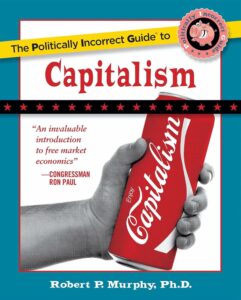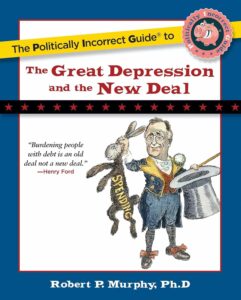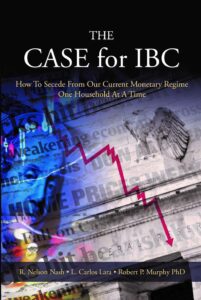ObamaCare Is Just a Stepping Stone to Nationalized Health Care
Home Depot joins the list of employers cutting back on medical coverage for their workers as ObamaCare looms. This should not be surprising: It is a logical consequence of the incentives set up by the scheme, just as surely as colleges are now cutting back on the courses they offer, in order to keep more of their faculty from crossing the “full time” threshold and thus triggering greater obligations.
Many people roll their eyes at “those idiots in Washington!” as if these obvious outcomes are somehow a surprise. No, the people in Washington have trained economists on their staffs. They understand incentives, even though their rhetoric suggests that they don’t. Over the coming years, as the delivery of US healthcare suffers and citizens become justifiably outraged, they will be led to demand greater and greater government involvement to thwart the “greedy” insurance companies and “overpriced” hospitals. This is part of the plan, as some glib proponents of ObamaCare have let slip.
For example, Senate Majority Leader Harry Reid in August was interviewed for a PBS program “Nevada Week in Review” in which the following exchange occurred:
“What we’ve done with Obamacare is have a step in the right direction, but we’re far from having something that’s going to work forever,” Reid said.
When then asked by panelist Steve Sebelius whether he meant ultimately the country would have to have a health care system that abandoned insurance as the means of accessing it, Reid said: “Yes, yes. Absolutely, yes.”
Or consider Paul Krugman, who recently wrote at his NYT blog that the solution for rising health care costs is to have the entire health sector run on the pattern of Medicaid:
Everyone who’s serious about the budget realizes that to the extent we do have a long-run fiscal problem…it’s mainly about health care costs…
Meanwhile, we have ample evidence that we do know how to control health costs. Every other advanced country does it better than we do — and Medicaid does it far better than private insurance, and better than Medicare too. It does it by being willing to say no, which lets it extract lower prices and refuse some low-payoff medical procedures.
…
But the problems of access, such as they are, would largely go away if most of the health insurance system were run like Medicaid, since doctors wouldn’t have so many patients able and willing to pay more.…So, I’m not proposing that we turn the whole system into Medicaid any time soon. But what I take from the data is that if and when we feel the need to make tough choices — really, really make tough choices, not use the rhetoric of tough choices to justify what conservatives wanted to do in any case, namely privatize everything in sight — health cost control won’t turn out to be that hard after all. [Bold added.]
Ludwig von Mises argued that the “mixed economy” was an unstable system, because each new government intervention would lead to undesirable consequences that would then invite further interventions. No one has the right to be surprised when so-called ObamaCare doesn’t work, and sets up calls for a total government takeover of health care. That seems to have been the plan all along.
My Final (We Hope!) Word on Paul Krugman and Inflation Predictions
In my last post, I suggested that Paul Krugman has not been entirely candid with his readers on the issue of how economists from the Keynesian versus rival camps predicted the movement of prices as the recession struck. Yes yes, the Austrian purists don’t like to even talk about this stuff, but it’s Krugman’s only real trump card–“We were right about inflation! Those idiots were wrong! If you believe in science, you have to support stimulus!”–so I want to make sure we understand just how slippery Krugman has been. Even I didn’t fully appreciate it until recently.
To make my point, let me just do the mirror image of what Krugman has done, and tell me if you think (a) it’s above board and (b) Krugman, DeLong, et al. would be fine with me saying the below:
HYPOTHETICAL MURPHY ANALYSIS: When we first entered this crisis, economists and economic pundits quickly sorted themselves out into two camps. One camp — the “hawks” — basically said, printing money will only make things worse; there’s no such thing as a liquidity-trap economy, and (price) deflation is not the threat right now. The other camp said that we were Japan, and that accelerating (price) deflation was just around the corner.
These differing views reflected fundamental differences in economic models — differences that tended to be associated with political leanings, although there are a handful of politically conservative market monetarists out there.
And history has given us as decisive a test of rival economic theories as I’ve ever seen. If past experience is any guide, however, all of this will make no difference. Deflation phobia does not, it seems, require any actual deflation to persist. And being a Keynesian — or, in general, being a left-winger — means never having to say you’re sorry.
So, what do you guys think? I imagine you’d say the above is rather self-serving, since it makes it sound as if the doves predicted (price) deflation, while the hawks merely predicted “not deflation.”
Yet as I said, that’s exactly what Krugman has been doing, in his frequent victory laps on the vindication of IS/LM compared to the “models” of his rivals. The above hypothetical quotation was adapted from this Krugman piece (from July 2013), but anyone who reads him even occasionally knows that Krugman has been trotting out this “as decisive a test of rival economic theories as I’ve ever seen” line numerous times. When that’s his purpose–namely, to say that if people like me had any integrity, we’d admit abject failure–he casts the Keynesians as merely predicting, “No soaring interest rates and no soaring price inflation.”
Yet in reality, that’s not what Krugman thought would happen when the crisis first struck. As I walk through in this post, Krugman in February 2010 warned that the US was about to become Japan–which in context, meant actual reductions in core CPI. As I show in the post, the particular metric he was using turned around about 7 months after that warning, and within about 18 months had returned to 2005 levels. Furthermore, if you think I’m putting words in his mouth, Krugman himself linked to that very post in April 2013, and said of his 2010 analysis: “(In that post, I worried about deflation, which hasn’t happened; I’ve written a lot since about why).”
Note the parenthetical aside, and the timing: Krugman in April 2013 is mentioning in parentheses to his reader that oh yes, as of February 2010 he was “worried about deflation, which hasn’t happened.” In other words, Krugman entered this crisis with a model that predicted how prices would move in response to the economic situation, and chose his policies of government stimulus accordingly. He was wrong, and yet maintains the same policy recommendations.
As a last kicker, just to show how little Krugman cares about people on his side not adjusting their model in light of the new data, here’s how Krugman praised David Romer’s class notes earlier this week (i.e. September 2013):
I’ve mentioned David Romer’s nice formulation of modern applied macro — the way people actually think, as opposed to the intertemporal maximization with whipped cream that’s respectable. David now informs me that he has a set of publicly available class notes (pdf) that have been regularly updated, covering that ground even better — with an extensive section on the liquidity trap.
Romer’s notes still imply that a protracted liquidity trap should lead to accelerating deflation, which doesn’t seem to happen; I think most of us have turned to downward nominal wage rigidity as an explanation. In any case, this is more or less the state of the practical art, and I’m delighted to learn that he’s put it together. [Bold added.]
You see that? When it comes to right-wingers who predicted accelerating price inflation, their failure–and continued recommendation of hawkish policies–is evidence that they are knaves or fools.
In contrast, when David Romer is still teaching students with notes that imply a liquidity trap leads to accelerating price deflation, Krugman shrugs it off following a semicolon, and says the analysis is “more or less the state of the practical art” and is “delighted to learn that [Romer’s] put it together.”
What’s funny is that the fans of Paul Krugman actually believe that the only reason the people he calls fools and liars get upset, is because gosh darnit he’s just always so right. Nope, that’s not it.
Things Don’t Look Good for Those Fixated on Aggregate Demand
First let me relay Peter Klein’s take on the Fed’s non-taper announcement:
The above is a good summary of the Rothbardian view on our current situation.
Now, there have been some developments in just the last week or so that, in a just world, would cause severe angst in the psyches of those who have been blaming the Great Recession on inadequate demand.
First, there’s David Laidler’s surprising interview with Russ Roberts. Laidler is as old school monetarist as they come; he actually helped Friedman and Schwartz with their famous Monetary History that overturned the then-prevailing Keynesian explanation of the 1930s, and got economists thinking that the Fed committed a sin of omission. The omnipresent (on the Internet) von Pepe sent me the interview and drew my attention to the implications for poor Scott Sumner. Consider these excerpts:
Russ: And I would say especially if it originates in the financial sector. There’s some debate–you allude to it in your writing–about what I would call the ‘real side’ or the microeconomics side. And you point out that the Austrian view, the idea that both the 1929 collapse and the current mess did see a very rapid run-up on asset prices that suddenly collapsed; and that obviously caused some challenges for the financial sector.
Guest [David Laidler]: Yeah. I mean, that’s right. People keep calling these things ‘financial crises’. They are really asset market crises. And they happen on the margin between markets for financial assets and markets for real assets. Like real estate and factories and physical investment. I don’t think the monetarist story of the onset of the Great Depression by the way, or the monetarist story about the onset of this Great Recession, is quite plausible enough. I can’t find anything in the data in the 1920s or the data in the run-up to this event, that shows a degree of sort of conventional tightening of money growth that can account for the speed of the subsequent downturn. That really looks like, in both cases, an economy where something was going badly wrong in real asset markets, and it just needed a little bit of tap from the financial markets to set a downward spiral going. And, you’re right–the Austrians were the pioneers of this kind of analysis, in the 1920s even; and of course there are still Austrians around. And if I may sort of put in a plug for Cambridge, England, where John Maynard Keynes was, Keynes’s colleague, Sir Dennis Robertson was developing a parallel analysis to this in the 1920s. And he wrote a little textbook; and its 1928 edition has got a couple of paragraphs expressing his fears about what was likely to happen in the United States if that asset market boom kept on going. And this was before the Great Depression and before the stock market crash. In contrast, the representative of monetarism in the United States in the 1920s was probably Irving Fisher; and Irving Fisher didn’t see anything coming. He was just concentrating on the behavior of the price level and saying all is well, right down to October 1929. And indeed afterwards. So, I think we’ve got to give the Austrians and Dennis Robertson some credit. And I’d like to see our profession start taking that analysis a little bit more seriously. I mean the mainstream of our profession; because of course the people who have been propounding it are certainly professionals themselves. But they are in a minority.
And the part that excited von Pepe:
Russ: So, you think it’s much more than just a monetary phenomenon.
Guest: Yeah, I do. I never thought I would live to say this, but on this particular instance, I’m inclined to line up with the Austrians. I think they really have a point about this issue, about asset market distortions. After long periods of monetary stability.
Russ: This again puts you in a small group of economists who have learned something from the crisis. Most economists–I find it remarkable how many people have managed to keep their theological views unchanged by this experience.
Guest: Well you must remember that I’m retired, so I don’t have to worry about pleasing journal editors any more.
Russ: Yeah. Well, no comment. What would be your view on, going forward, would be the ideal monetary policy? Should we be doing something like the Taylor rule? Do you think anything positive about Scott Sumner’s approach and that of others who argue for nominal GDP targeting? Milton at one point–he changed sometimes, but he argued for a steady growth rate in the rate of money. Where do you think we are right now?
Guest: Let me back up. Let’s think about a state of affairs in which we are out of the aftermath of the recession. So, two or three years more down the path. I still am pretty happy with the inflation rate as the target of policy. I base this a lot on Canadian experience. We’ve been targeting the inflation rate since 1991; we’ve done it pretty successfully. We didn’t have a big asset market crisis here. We had not had a recession until 2008 since 1991. So inflation targeting worked pretty well for us. And it worked I think because it was a very explicit policy target agreed between the government and the Bank of Canada. It wasn’t an informal thing, as it was in the Fed. It was discussed continually. And as time passed, the targets were hit and it gained in credibility. So I would see no reason to go from that to a nominal GDP target. I don’t like nominal GDP as a target for policy, for the simple reason is: that’s a variable that’s measured with a lag and it’s subject to a lot of revision. And I don’t see how you can run forward-looking monetary policy targeting the behavior of a variable that you don’t get a good reading on for 18 months after it’s happened. With inflation targeting based on a Consumer Price Index, you get timely data and it’s not subject to revision. The indices are not perfect, but they are well understood by policy makers and the general public understands them as well. If I tell my wife the Bank of Canada is targeting nominal GDP, she’ll just look at me and wonder what on earth I’m talking about. If I tell her they are telling her they are targeting the rate at which the cost of living goes up, she understands that. And knowing that there is that target out there affects the behavior of ordinary consumers and producers, not just financial markets.
However, as exciting as it is to see Laidler throw Market Monetarism under the bus, what’s really got my attention is John Cochrane’s paper castigating the liquidity trap. At times like this, I wish I were a tenured college professor, because if Cochrane actually did what he claims to have done, this is absolutely devastating to both Krugman and Sumner. First Cochrane sets up the context:
New-Keynesian models produce some stunning predictions of what happens in a “liquidity trap” when interest rates are stuck at zero. They predict a deep recession. They predict that promises work: “forward guidance,” and commitments to keep interest rates low for long periods, with no current action, stimulate the current level of consumption. Fully-expected future inflation is a good thing. Growth is bad. Deliberate destruction of output, capital, and productivity raise GDP. Throw away the bulldozers, let them use shovels. Or, better, spoons. Hurricanes are good. Government spending, even if financed by current taxation, and even if completely wasted, of the digging ditches and filling them up type, can have huge output multipliers.
Even more puzzling, new-Keynesian models predict that all of this gets worse as prices become more flexible. Thus, although price stickiness is the central friction keeping the economy from achieving its optimal output, policies that reduce price stickiness would make matters worse.
In short, every law of economics seems to change sign at the zero bound. If gravity itself changed sign and we all started floating away, it would be no less surprising.
And of course, if you read the New York Times, people like me who have any doubts about all this are morons, evil, corrupt, and paid off by some vast right-wing conspiracy to transfer wealth from the poor to the secret conspiracy of hedge fund billionaires.
OK, now on to the devastation (if true):
So I spent some time looking at all this.
It’s true, the models do make these predictions. However, there is a crucial step along the way, where they choose one particular equilibrium. There is another equilibirum choice, where all of normal economics works again: no huge recession, no huge deflation, and policies work just as they ought to.
So Cochrane first shows that he knows how to reproduce Krugman’s (and Sumner’s, mind you) favored outcome: Cochrane can use a New Keynesian model to produce an economy in a perverse equilibrium in which big deficits help, and even the Fed just promising to be irresponsible in the future (without doing anything today) can help. Thus, you could use such a model to justify Bernanke’s rounds of QE and Obama’s stimulus package. People like Eugene Fama, John Cochrane, and little old me are shown to be complete fools. What’s even crazier, is that even though “sticky wages and prices” are the reason you get equilibrium unemployment in a New Keynesian model, Cochrane can reproduce Krugman’s claimed result that making prices and wages less sticky (though not perfectly flexible) will just deepen the slump.
However, Cochrane then uses the same models and finds that there are different equilibria, where all the rules of Henry Hazlitt (my term, not his) apply:
The paper shows that all the magical policies are absent in this equilibrium: The multiplier is always negative, announcements about the far off future do no good, and deliberately making prices sticker doesn’t help.
These are not different models. These are not different policies or different expected policies. Interest rates follow exactly the same path in each case, zero from t until T=5, and following the natural rate thereafter. These are different equilibrium choices of the same model. Each choice is completely valid by the rules of new-Keynesian models. I don’t here challenge any of the assumptions, any of the model ingredients, any of the rules of the game for computation. Which outcome you choose is completely arbitrary.
The difference between the calamitous equilibrium and the mild local-to-frictionless equilibirum, in this model, is just expectational multiple equilibria (with an implicit Ricardian regime.) If people expect the inflation glide path, we get the benign equilibrium. If they expect inflation to be zero the minute the trap ends, we get the disaster.
I won’t quote him, but Cochrane goes on to say that if you’re trying to use empirical evidence to decide which equilibrium we’re currently in, then the Krugman story implies very large (price) deflation during the liquidity trap, whereas the “Treasury View” (aka classical economics aka full-employment economics aka “micro 101”) only works if we assume there have been impediments to the supply side since 2008. Hmm, can anybody think of any government policies that would hamper the economy since 2008?
And then, just to make sure we all agree that the interventionist New Keynesian approach “predicts” price deflation for times like ours, here’s Krugman commenting just yesterday nonchalantly on David Romer’s class notes:
I’ve mentioned David Romer’s nice formulation of modern applied macro — the way people actually think, as opposed to the intertemporal maximization with whipped cream that’s respectable. David now informs me that he has a set of publicly available class notes (pdf) that have been regularly updated, covering that ground even better — with an extensive section on the liquidity trap.
Romer’s notes still imply that a protracted liquidity trap should lead to accelerating deflation, which doesn’t seem to happen; I think most of us have turned to downward nominal wage rigidity as an explanation. In any case, this is more or less the state of the practical art, and I’m delighted to learn that he’s put it together.
Everyone catch the part I put in bold? The “state of the practical art”–you know, the approach that has blown the Austrians and austerians out of the water for its superior predictive ability–predicted accelerating deflation, according to Krugman. (NB, I think Cochrane’s NK model instead predicted an initially huge price deflation, which gradually shrinks as the liquidity trap continues. Not sure why there is a discrepancy, or maybe I’m misunderstanding.) But no worries, Krugman et al. just patched that up by turning to “downward nominal wage rigidity as an explanation.”
So, from now on, whenever any Keynesian guffaws at my inflation worries, I’m going to say, “I’m a scientist. In light of the new data, I realized that in 2009 I gave insufficient weight to the inertia in CPI, which I call the ‘ceiling friction coefficient.’ Other than that, my model came through with flying colors.”
Mises on the Invisible Hand Metaphor
From page 240 of the Scholar’s Edition of Human Action:
Theism and Deism of the Age of Enlightenment viewed the regularity of natural phenomena as an emanation of the decrees of Providence. When the philosophers of the Enlightenment discovered that there prevails a regularity of phenomena also in human action and in social evolution, they were prepared to interpret it likewise as evidence of the patcrnal care of the Creator of the universe. This was the true meaning of the doctrine of the predetermined harmony as expounded by some economists. The social philosophy of paternal despotism laid stress upon the divine mission of kings and autocrats predestined to rule the peoples. The liberals retorted that the operation of an unhampered market, on which the consumer–i.e., every citizen–is sovereign, brings about more satisfactory results than the decrees of anointed rulers. Observe the functioning of the market system, they said, and you will discover in it the finger of God.
Potpourri
==> Next January I’ll be debating Bill Still (of “Money Masters” fame) at the “Save Long Island” forum. I gather we both dislike the present financial system, but have rather different solutions.
==> A funny post from Matt Walsh on the crucible that is parenting.
==> If you’re a Louis CK fan, check out these three clips from when he recently spent the whole hour talking with Conan (his former boss).
==> This 1981 debate between David Friedman and George Smith is awesome, if only to see everybody looking like they are doing cameos in an episode of CHiPS. As David R. Henderson notes, you can see Jeff Hummel at the 1:44:30 mark. The whole thing is groovy.
==> The best part of this 45-second video (watch out, some naughty words) is the guy in the background trying to be a peacemaker. First he says, “Don’t go down there man!” to the drunk punk talking trash to the ex-boxing champion, and then he says, “Champ don’t do it!” Alas, the champ does it.
==> Greg Morin wonders whom would Jesus bomb?
God Can Only Help You If You Believe He’s Able?
The following passages from chapter 6 of the gospel of Mark explain what happened when Jesus had already begun His ministry but returned to Nazareth:
1 Then He went out from there and came to His own country, and His disciples followed Him. 2 And when the Sabbath had come, He began to teach in the synagogue. And many hearing Him were astonished, saying, “Where did this Man get these things? And what wisdom is this which is given to Him, that such mighty works are performed by His hands! 3 Is this not the carpenter, the Son of Mary, and brother of James, Joses, Judas, and Simon? And are not His sisters here with us?” So they were offended at Him.
4 But Jesus said to them, “A prophet is not without honor except in his own country, among his own relatives, and in his own house.” 5 Now He could do no mighty work there, except that He laid His hands on a few sick people and healed them. 6 And He marveled because of their unbelief. Then He went about the villages in a circuit, teaching.
Verse 4 is famous; people quote that a lot. But it’s verse 5 that has always intrigued me, especially the part I put in bold. Of course I’m dependent on the English translations, but at face value, in context it suggests that Jesus could only heal people who believed in Him. In other words, the verse does not say “He refused to do a mighty work,” or even the more neutral “He did no mighty work.” Nope, it says “He could do no mighty work,” except for some minor healings that aren’t impressive for Jesus.
I don’t want to bring up the theological implications at the moment, but just from reading the passage, it sure sounds like Jesus needs the crowd to be with Him in order to really show the full potential of His power.
There are other passages too where you see this theme. On several occasions (here’s just one), Jesus will say words to the effect of, “Your faith has healed you,” as opposed to, “My power just healed you.”
Even the apparent counterexample of Lazarus is more nuanced than I had remembered (since I just re-read it). When Jesus raised Lazarus from the dead, obviously Lazarus himself wasn’t alive to “really believe it” and so somehow psychosomatically heal himself. However, before raising Lazarus Jesus has an exchange with his sister Martha, who volunteers that Jesus not only could have prevented Lazarus from dying, but even now has the power to bring him back. She also affirms that He is the Christ.
Then, even later when Martha warns Jesus that Lazarus has been in the tomb for four days and that there would be a stench–a sign of disbelief–Jesus reminds her, “Did I not say to you that if you would believe you would see the glory of God?” So even the story of Lazarus, which I had always filed away as a counterexample of people being healed by their faith in Jesus, is actually a lot more nuanced.
I don’t really have a major conclusion here, just pointing out that this passage always struck me as very interesting. On the one hand, the gospels portray Jesus as God Himself, and yet on the other, there are several places where it sounds as if God can only help us if we’re at least receptive to it. Indeed, that’s arguably the central message of Christianity itself: Jesus will give you eternal life, but it only “works” if you believe that He can. Try this story for a perfect illustration.
Last point: I realize our atheist friends will be able to twist this into a sadistic God in need of constant praise before He relents from punishing people. OK, that’s one way of looking at it, but reading the accounts of Jesus that’s certainly not how He is portrayed. He wants to do mighty works in Nazareth, He wants to gather the children of Jerusalem as a hen gathers her chicks, but they refuse to accept His help.
Not Everyone Saw the Recession Coming
Oh man, I saw this op ed by Don Luskin linked by a recent Krugman post. (Well, it might have been from somebody Krugman linked.) I was annoyed with Krugman and the guy he was linking, but Luskin’s piece stole the show. At this point, let me just tell you that Luskin wrote this while George W. Bush was still in office. Check out some of these quotes:
“It was the worst of times, and it was the worst of times.”
I imagine that’s what Charles Dickens would conclude about the current condition of the U.S. economy, based on the relentless drumbeat of pessimism in the media and on the campaign trail….
It’s a virus — and it’s spreading. Do a Google News search for “since the Great Depression,” and you come up with more than 4,500 examples of the phrase’s use in just the past month.
But that doesn’t make any of it true. Things today just aren’t that bad. Sure, there are trouble spots in the economy…And unemployment figures are up a bit, too. None of this, however, is cause for depression — or exaggerated Depression comparisons.
Overall, the pessimists are up against an insurmountable reality: In the last reported quarter, the U.S. economy grew at an annual rate of 3.3 percent, adjusted for inflation. That’s virtually the same as the 3.4 percent average growth rate since — yes — the Great Depression.
Why, then, does the public appear to agree with the media? A recent Zogby poll shows that 66 percent of likely voters believe that “the entire world is either now locked in a global economic recession or soon will be.” Actually, that’s a major clue to what started this thought-contagion about everything being the worst it has been “since the Great Depression”: Politics.
…
So much for [candidate] Obama’s hyperbole about our terrible economy. But what about the media’s?A housing “slump,” a housing “crisis”? A “severe” price decline? According to the latest report from the National Association of Realtors, the median price of an existing home is up 8.5 percent from the low of last February. And according to the U.S. Census Bureau, the median price of a new home is up 1.3 percent from the low of last December. Home prices may not be at all-time highs — and there are pockets of continuing decline in some urban areas — but overall they’ve clearly stopped going down and have started to recover. So why keep proclaiming a “crisis” after it’s over?
…
This would suggest that anyone who says we’re in a recession, or heading into one — especially the worst one since the Great Depression — is making up his own private definition of “recession.” And probably for his own political purposes.
…
Whatever the political outcome this year, hopefully this will prove to be yet another instance of that iron law of economics and markets: The sentiment of the majority is always wrong at key turning points. And the majority is plenty pessimistic right now. That suggests that we’re on the brink not of recession, but of accelerating prosperity.
Yikes! That’s pretty bad, right? Now for the kicker: Luskin’s piece ran in the Washington Post on September 14, 2008. The day before Lehman filed for bankruptcy.
One last thing: Now that you’ve read the above, just click on this. Come on now kids. Do you at least see why I continue on this thankless mission?
P.S. To cover myself from all accusations of hypocrisy, let me remind everyone that I stupidly pooh-poohed Peter Schiff’s warnings as late as January 2007. In my defense, that was a lot earlier than September 14, 2008.
Potpourri
I’m just outside Chicago for the Illinois Libertarian Party annual extravaganza. Some “Freedom Karaoke” tonight, followed by lectures tomorrow. In the meantime:
==> Nick Rowe writes another blog post in which he calmly and methodically destroys the foundation of mainstream central banking theory. (You may recall a few months ago Nick showed in a standard New Keynesian model a large cut in current government expenditures could restore full employment, and Nick claimed that surely Krugman and DeLong would endorse his textbook discussion.) Nick is like some crazy guy playing Solitaire on the deck of the Titanic. You strike up a conversation with him, and he mumbles something about realizing we are headed straight for an iceberg. “Whoa, are you serious?! Shouldn’t we tell the captain or something?!” you exclaim. But Nick just mutters something about it being his mother’s birthday next week, as he stares at his cards.
==> Tom Woods now has his own radio show. Life will never be the same.
==> A long but interesting (we hope!) conversation between Daniel Sanchez and me. The main topic is my upcoming Mises Academy class, but it soon pivots away from an infomercial and turns into some deep thoughts on economic theory.
==> JP Koning knows that bank reserves aren’t ripe avocados, but “the expert” Woodford disagrees. (And where are the coconuts in this model?)
==> Scott Sumner reasons from a price change and hails Ben Bernanke. (I’ll come back to this later, as Scott specifically mentions me in his remarks on interest rates.)
==> I’m not attending, but FYI there is an upcoming Austrian Scholar’s Conference in Toronto, hosted by the Mises Institute of Canada.
==> You hardcore policy wonks might be interested in IER’s comment on the government’s rule on microwave ovens. (Yes, the federal government issues rules pertaining to “Off” and “Standby” modes for microwaves. I think that falls under the “necessary and proper” clause.)







Recent Comments